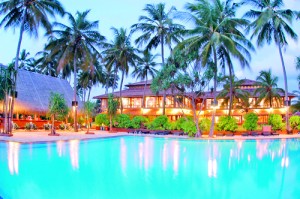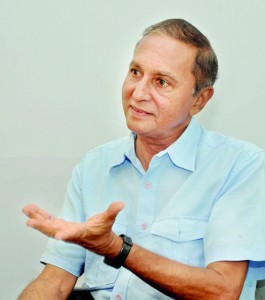Merging construction with landscape
Driving down a winding lane and up to architect Mihindu Keerthiratne’s offices in Nawala, we find our way barred by an imposing white gate. A narrow entrance on the side allows us access and we step in to find ourselves in a sprawling property many acres large. Rows of flowering sentinel trees stand guard along a road that leads past large greenhouses, where hundreds of plants flourish under careful supervision. Elsewhere on the property, a lab is geared to produce six million plants a year. (Currently, it produces tissue cultures of native Australian plants destined for export.) But the real heart of the premises are the discreet offices tucked away in one corner. Over more than 30 years of their existence, Mihindu Keerthiratne Associates (MKA) have produced designs for hundreds of buildings of every description, counted among which are some of Sri Lanka’s most famous hotels.

Multi-award winning Ranweli Holiday Hotel in Waikkal
The Sri Lanka Institute of Architects (SLIA) acknowledged this and the many achievements of an extraordinary career when they presented Mr. Keerthiratne with their highest honour in late February. When he accepted the Gold Medal from the hand of President Mahinda Rajapaksa at the inauguration of SLIA’s 32ndannual sessions, Mr. Keerthiratne became one of only seven Sri Lankans to have received this award. For the architect, this is the most recent in a long line of prestigious appointments and honours that included being named Deshamanne Sasanabandu by the Sri Lanka Vishva Samadhi Padanama in 2007.
Twice President of the SLIA, he has worn many hats over the course of his career. Included among the highlights are his stints as the Director, Board of Management, Urban Development Authority (1993 -1995), his appointments as Chairman of the Advisory Committee, Ministry of Interior(March 2002) and as Director of the Road Development Authority (May 2002). He was appointed a member of the Executive Committee of The Ecotourism Society of Sri Lanka in 1999 (and remains a member to date) and was the Elected Founder Chairman of the South Asian Association for Regional Co-operation of Architects (SAARCH). Among a host of other honours is also listed his spell as the President of the Floriculture Produce Exporters Association.
In the light of the last on the list, our interview begins with a conversation about plants. “I have always loved gardening,” says Mr. Keerthiratne. Admittedly though, in his professional life he tends to work on a scale that calls for bulldozers and backhoe loaders rather than spades and rakes. He and his team moved into these offices only seven years ago and it’s hard to believe the property the nurseries stand on was once all unusable marsh land. It was when Mr. Keerthiratne set about remedying that that he also began what turned into an entirely new business: the Mike Group of Companies’ heavy equipment branch. However, despite the many successes of this

Mihindu Keerthiratne
business, Mr. Keerthiratne remains most widely known as an architect.
The eldest son of the late Minister of Posts and Telecommunication N.H. Keerthiratne, he began his education at St. Anthony’s College Kandy and went on to graduate from the University of Hong Kong with a B.Arch in 1969. The winner of the prestigious Edward D. Mills award for outstanding performance, he later spent a period of time living and working in Japan where he was much influenced by the distinctiveness of the Japanese aesthetic and their minimal approach to design. Returning to Sri Lanka, he then joined Justin Samarasekera Associates. MKA was founded in 1976.
His work, most notably in the case of the multi-award winning Ranweli Holiday Village in Waikkal was often visionary. Named one of the ‘Top 50 Eco-Lodges of 2009’ by the editors of National Geographic Adventure magazine, the hotel is located on a beautiful 22-acre peninsula where river meets coconut estate meets mangroves meets sea. “That was one of the hotels that was different to the others,” says Mr. Keerthiratne of the project that was completed in 1973.
In a time before ‘eco-tourism’ was a buzzword, he designed buildings that trod lightly on the earth and that were perfectly suited to their context. At Ranweli, the absolute minimum number of trees was uprooted and the architects took inspiration from the grid system of the plantation itself. In fact, so exacting were they that only one tree was uprooted per bungalow and its trunk was used as a pillar in the construction. Elsewhere on the property, boardwalks were constructed to allow guests to walk into the mangroves themselves and foliage planted specifically with the intention of attracting butterflies. Even today the promise of a number of bird and animal sightings continues to draw in wildlife enthusiasts.From the beginning visitors were encouraged to engage with local communities as part of the hotel’s sustainable ethos.
Another hotel that Mr. Keerthiratne remains justifiably proud of is the Taj Exotica in Bentota but he is also well known for his work as the architect of the Pasikudah National Resort and the Nilaweli Beach Hotel in Trincomalee, the Earl’s Regency Hotel and Citadel Hotel in Kandy, the Royal Palms Hotel and the Tangerine Beach Hotel in Kalutara among many others.
Many of these hotels were built on wonderful pieces of property that offered guests unique access to pristine natural landscapes as well as to an abundance of wildlife. As the architect, Mr. Keerthiratne was called upon to find ways to not just preserve the natural spaces around the building but to see how to merge the construction with the landscape. He did so by intruding as little as possible and making the most of features that already existed – courtyards structured around hollows in the rock and boulders left to stand guard outside buildings. In several cases, his determination to do so presented not insignificant challenges but these have eased over the decades as the concepts of eco-tourism have gone mainstream.
In his interview with the Sunday Times, Mr. Keerthiratne spoke of the future of tourism infrastructure as being shaped by the forces of sustainable design and cultural context. A new generation of architects have grown in a tradition that encourages them to design keeping in mind their environment and their heritage, he said. The result are buildings increasingly tailored to the Sri Lankan landscape: buildings that rely on natural ventilation and clever design to defeat the heat and the dust, but still make the most of the natural beauty that surrounds them.
Nurturing young architects and recognising outstanding local talent have always been key priorities and one of his enduring legacies as the President of the SLIA will be having initiated the prestigious Architects Awards scheme in 1991. Mr. Keerthiratne sees government initiatives focused on development as paving the way for much needed infrastructure to support tourism and believes that the new design aesthetics will arise from Sri Lanka itself. He also applauds the development he sees taking place across the country, praising initiatives that focus on laying the groundwork for future expansion of cities and critical infrastructure across the island.
Currently, Mr. Keerthiratne is juggling several exciting projects, but the most interesting of all may be unfolding in his personal life. A hands-on father to two young children – a boy and a girl aged 4 ½ and 6 – he says he’s enjoying parenthood a great deal. “It’s quite a challenge. I think it’s quite an interesting phase of my life,” he says, adding “it’s part of the enjoyment.” As his secretary of 26 years will tell you, he’s busier than he’s ever been before but around his office, Mr. Keerthiratne is known for his calm in the face of stress. It’s a virtue no less valuable to him than his skill as an architect –“Nothing is a problem for me. I try to solve problems light heartedly. In this stressful world, you have to learn to be calm. It’s not worth living otherwise.”



